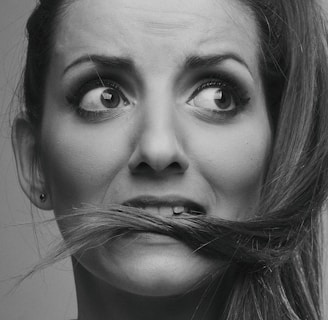Haircare in Your 30s: What Changes to Expect
Your 30s bring new changes to your hair—slower growth, texture shifts, and even the first signs of grays. Learn how to adapt your haircare routine with the right products, nutrition, and habits to keep your locks healthy, voluminous, and vibrant!
Yilda
12/5/20243 min read


Your 30s are a time of change—not just in life but also in your hair! You may start noticing differences in texture, shine, thickness, and even how your hair reacts to products. But don’t worry! With the right care, you can keep your hair healthy, strong, and beautiful. Let’s dive into what happens to your hair in your 30s and how you can adjust your routine to keep it looking its best.
How Your Hair Changes in Your 30s
1. Slower Hair Growth
In your teens and 20s, your hair grows at its fastest. But as you enter your 30s, your hair’s growth cycle slows down. This means your hair may not grow as long or as quickly as it once did. This happens because your body naturally produces less collagen and keratin, two important proteins for strong, healthy hair.
What to Do:
Eat protein-rich foods like eggs, fish, and nuts to support hair growth.
Consider using biotin supplements or hair growth serums.
Massage your scalp with essential oils like rosemary or castor oil to boost circulation and promote growth.
2. Changes in Thickness & Density
Some people notice that their hair starts to thin or feel less voluminous in their 30s. This can be due to hormonal shifts, stress, or even genetics.
What to Do:
Use volumizing shampoos and conditioners that add body without weighing your hair down.
Avoid excessive heat styling, which can weaken hair strands.
Try a lightweight dry shampoo to add instant lift and fullness.
3. More Dryness or Oiliness
Your scalp’s oil production may change in your 30s, making your hair drier or oilier than before. Some people experience dryness because their scalp produces less natural oil, while others may notice greasier roots due to hormonal fluctuations.
What to Do:
If your hair is dry, use hydrating shampoos, deep conditioning treatments, and leave-in conditioners.
If your hair is oily, wash it with a gentle, sulfate-free shampoo and avoid over-washing, as this can cause your scalp to produce even more oil.
4. Increased Hair Shedding
It’s normal to shed up to 100 hairs a day, but if you’re noticing more hair in your brush or shower drain, it could be due to stress, diet, or changes in hormone levels.
What to Do:
Maintain a balanced diet with plenty of vitamins like iron, zinc, and vitamin D.
Avoid tight hairstyles that pull on your scalp.
Use gentle, sulfate-free hair products to prevent unnecessary breakage.
5. First Signs of Grays
Many people start seeing their first gray hairs in their 30s. This happens when the pigment-producing cells in your hair follicles slow down or stop producing color.
What to Do:
Embrace your grays! Silver strands can be stylish and trendy.
If you prefer to cover them, try semi-permanent hair dyes or root touch-up sprays for a natural look.
Keep hair hydrated with deep conditioners, as gray hair tends to be drier and coarser.
6. Texture Changes
Your hair may feel different than it did in your 20s. Some people notice their straight hair becoming wavier, or their curls loosening.
What to Do:
Adjust your styling routine to enhance your hair’s natural texture.
Use curl-enhancing creams or texturizing sprays if your hair is getting wavier.
Avoid excessive brushing, as it can make wavy or curly hair frizzy.
Best Haircare Routine for Your 30s
1. Choose the Right Shampoo & Conditioner
Pick a shampoo and conditioner based on your current hair needs:
For dry hair: Use moisturizing products with ingredients like argan oil or shea butter.
For oily hair: Opt for a lightweight, balancing formula with tea tree oil or charcoal.
For thinning hair: Try biotin-infused shampoos that support hair strength.
2. Hydrate & Nourish Your Hair
Moisture is key to keeping your hair healthy.
Use a deep conditioning treatment once a week.
Apply a leave-in conditioner to protect your hair from daily stress.
Drink plenty of water to keep your scalp hydrated from the inside out.
3. Limit Heat Styling & Chemical Treatments
Excessive heat from curling irons, straighteners, and blow dryers can weaken hair over time.
Use heat protectant sprays before styling.
Try heatless styling methods like braiding damp hair for waves.
Limit harsh chemical treatments like bleaching or relaxing, as they can cause long-term damage.
4. Trim Regularly
Split ends can make your hair look dull and frizzy.
Get a trim every 6–8 weeks to keep your hair looking fresh and healthy.
If growing out your hair, ask your stylist for “dusting,” a technique that removes split ends without losing length.
5. Scalp Care Matters
A healthy scalp means healthy hair!
Massage your scalp to boost circulation and promote hair growth.
Exfoliate with a scalp scrub once a month to remove buildup.
Avoid harsh hair products with sulfates and alcohol that dry out the scalp.
Final Thoughts
Your hair will naturally change in your 30s, but with the right care, it can remain strong, shiny, and full of life. Focus on hydration, nourishment, and protection, and adjust your routine as needed. Whether you’re dealing with thinning, dryness, or new grays, remember—healthy hair starts with healthy habits!
Quality
Experience premium haircare with nature’s best ingredients.
Innovation
Results
contact@hairukrave.com
© 2024. All rights reserved.
Satisfaction
Affiliate Disclosure: This post may contain affiliate links, which means I may earn a small commission at no extra cost to you if you make a purchase through these links. I only recommend products I truly believe in and have researched. Your support helps keep this blog running—thank you!
